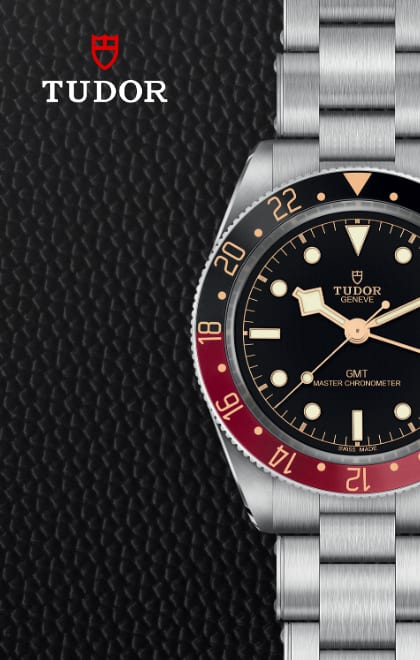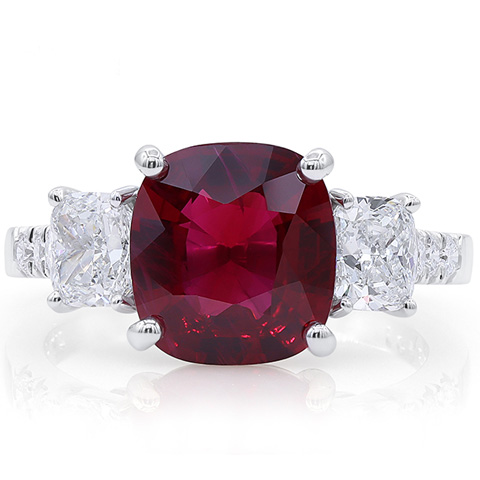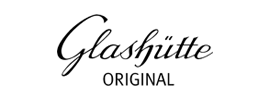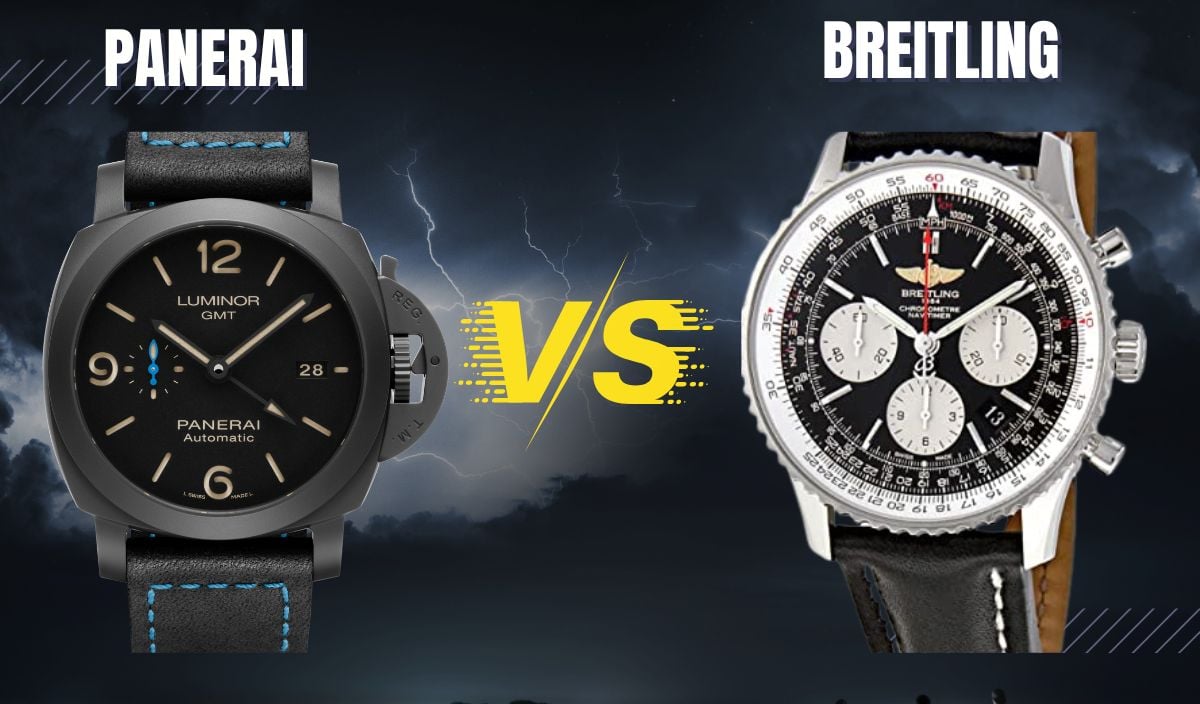
Panerai vs. Breitling (EVERYTHING to Know From Past to Present)
In this article, I will be providing information to assist in making the best decision on whether to purchase a Panerai or a Breitling wristwatch.
With this being the mission, I believe that any consideration of either watch brand cannot truly be made without knowing the rich histories of both watch houses.
Panerai History- Early Years
Panerai was founded in 1860 by Giovanni Panerai in Florence, Italy. From its inception, the shop was both a retail establishment and one of the first watchmaking schools in Italy.
By 1916, Panerai was producing high-precision instruments at the request of the Italian Royal Navy.
As a requirement, the Navy wanted dials that could easily be read in the dark and underwater.
Hence, the patented process of a highly luminous compound (originally a radium paste) was created and patented and the original “Radomir” was produced. This luminescence became a key element of the Panerai collection.
In 1936, the Radiomir prototype was developed for the Italian Royal Navy. These pieces needed to meet the parameters of a high-strength diving timepiece.
This was accomplished by modifying a watch case supplied by Rolex and was referred to as the 2533 prototype. By the 1940s the “Radiomir” had evolved into the instrument that most are familiar with today (ref. 3646). The characteristics of this watch consist of the following:
- A large cushion-shaped steel case with a 47mm diameter
- Highly luminous dial and markers
- Wire lugs that are welded to the watch case
- High-quality manual mechanical movement (at that time a Cortebert/Rolex 618 caliber.)
- A tan, water-resistant strap long enough to be worn over any protective clothing.
An additional advancement was the addition of a modified dial using overlapping discs, known as sandwich dials.
The upper part was comprised of anodized aluminum with perforated indexes and numbers to make the radium paste more luminescent and legible.
The Luminor
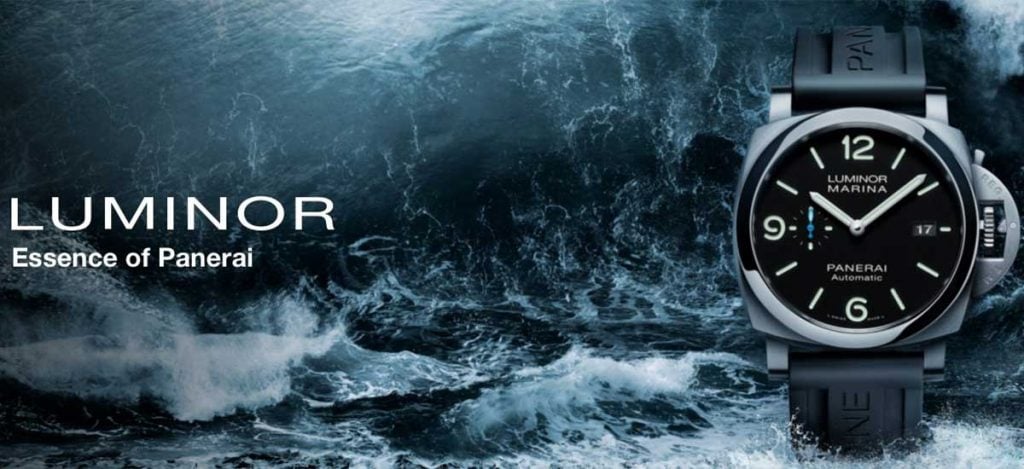
In 1949, the “Luminor” name was issued a separate patent due to the luminescent properties of the dial.
Instead of a radium paste (which carried various risks due to emissions), Panerai developed a tritium-based substance, a hydrogen isotope, that was safer and did not sacrifice luminosity.
Because of these developments, the patent was acquired and became synonymous with the dial qualities.
Another significant engineering feat was achieved in 1956, when Panerai, in developing a diving watch for the Egyptian Navy, introduced the patented crown protecting device which is structurally most identifiable within the Panerai collection today.
Throughout the 1960s the “Luminor” continued to evolve and was improved upon. The crown protection bridge was adapted to the watch case and advancements were also made in its movement.
The Swiss-made Angelus SF240 mechanical movement was employed which featured an 8-day power reserve. This power reserve feature would become part of the very DNA of the brand.
Another major innovation is that some of the solid and closed-back watches were replaced with a plexiglass window allowing one to view the movement.
At this time, Panerai was one of the first watch houses to outfit a watch accordingly. Today, this is a common feature on high-end brands bearing either mechanical or automatic watch movements.
Panerai Tourbillion in the 21st Century
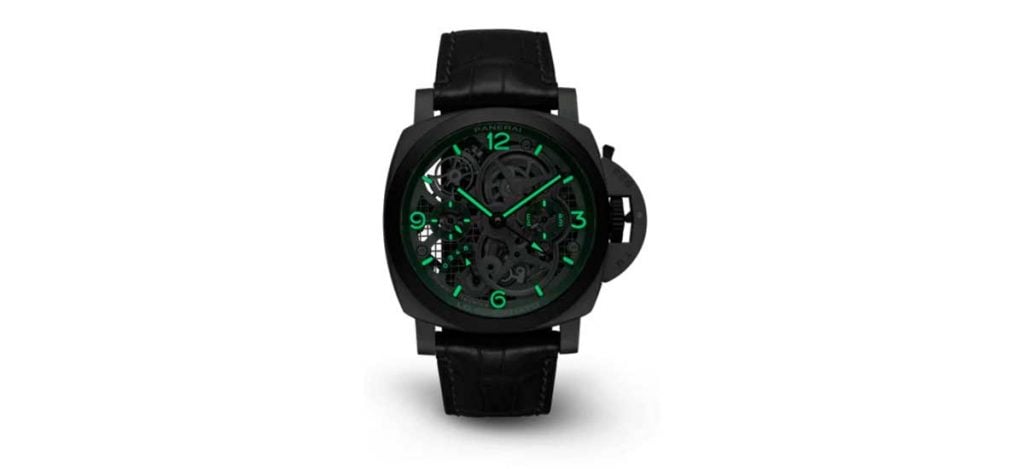
As Panerai entered the 21st century, the first of many in-house created movements were introduced.
In 2005 the P2002, a hand-wound mechanical with GMT function and an 8-day power reserve was unveiled.
Then, in 2007, the P2003, P2004, and P2005 were introduced. What distinguishes the P2005 is its most elegant tourbillon complication.
A tourbillon is an addition to the mechanics of a watch escapement to increase accuracy. In a tourbillon, the escapement and balance wheel are mounted in a rotating cage aiming to eliminate errors of poise in the balance giving a uniform weight. It was initially developed by the watchmaker Abraham Louis Brequet in 1795.
The unique characteristic of the Panerai tourbillon is that the cage housing the balance wheel and the escapement rotate on an axis that is not parallel to the balance wheel axis but perpendicular to it.
Unlike traditional tourbillons in which the cage completes one rotation per minute, the cage in the Panerai completes one rotation in thirty seconds. Very innovative.
Panerai continued to develop and create more in-house movements and incorporated more and more complicated features into their collection.
In 2010, a commemorative watch and clock were introduced to celebrate the 400th anniversary of Galileo’s first celestial observations.
Incorporating a variety of complications, these models continued to build on the creative and innovative reputation of the brand.
2013 saw the launch of the P9100 caliber, an automatic movement with chronograph flyback function, the P9100/R with a regatta countdown feature, and the P5000 caliber hand-wound movement with an eight-hour power reserve.
A pocket watch with both GMT and a tourbillon with a ceramic case were also introduced to the watch world.
2014 saw Panerai open a brand new watchmaking facility in Neuchatel, Switzerland. The innovation continued with the P4000 caliber, an automatic movement distinguished by an off-centered oscillating weight.
Panerai Radiomir and Luminor Due
Over the past eight years, Panerai launched the Radiomir 1940-minute repeater carillon tourbillon and the new Luminor Due case.
The Radiomir is the most complicated watch Panerai has ever produced. It incorporates the exclusive tourbillon regulator and the remarkable double repeater mechanism that chimes either local time or a second-time zone with the ability to sound every hour, every ten minutes, and every single minute using 3 hammers striking three different sounds.
A low sound for hours, an intermediate one for 10-minute periods, and a higher tone for minutes.
The Luminor Due reflects the thinnest automatic movements ever created by Panerai and is faithfully inspired by the classic 1950s model.
Panerai Latest Innovations
Strides in using various materials such as carbon and the development of BMG-TECH which is a bulk metallic glass with a disordered atomic structure obtained through a high-pressure injection process at a high temperature further advanced the Panerai collection.
2018 was marked by the unveiling of two remarkable innovations, the first being the Lo Scienziato-Luminor tourbillon GMT with a 3D printed titanium case coupled with the P2005/T skeletonized movement with a tourbillon regulator.
The second complication was the L’Astronomo-Luminor 1950 tourbillon moon phases equation of time GMT.
This is the first Panerai creation to have a moon phase indication and an innovative system using a polarized crystal to indicate the day.
To celebrate the 70th anniversary of the patented Luminor name, the company created a brilliant innovative model with a greater luminosity that is guaranteed for seventy-plus years.
Breitling History
Breitling was founded in 1884 by Leon Breitling. By 1892, he moved his watchmaking operations to La Chaux-de-Fonds, Switzerland and the following year patented his first movement that had a power reserve of eight days.
Breitling also introduced the pulsometer which measured a patient’s pulse using a logarithmic caliber and led to great popularity among physicians.
He followed this up by creating a chronograph with two-fifths of a second accuracy which became a benchmark at the time.
Within ten years Breitling had sold upwards of 100,000 chronographs and stopwatches. 1905 saw the development of a patented pocket watch tachymeter, which would be the precursor to the speedometer found on automobiles today.
He slowed the second hand down to make one revolution around the dial in four minutes, thus allowing the user to measure any speed between 15 and 150 km/h.
As the second generation of Breitlings joined the business, the development of a wrist-worn chronograph ensued that employed an independent pusher at the two o’clock position.
This separated the function of the Chrono features from the crown on the watch simplifying use and minimizing errors.
By 1923, the “reset to zero” function was moved back to the crown position while keeping the “start/stop” functions at the two o’clock position.
This enabled the user to add successive times without having to reset the hands to zero. 1934 saw the addition of a second pusher at the four o’clock position which was a breakthrough and provided the blueprint for the present-day chronograph. This pusher was used exclusively to zero the chronograph.
Breitling’s Chronomat Design
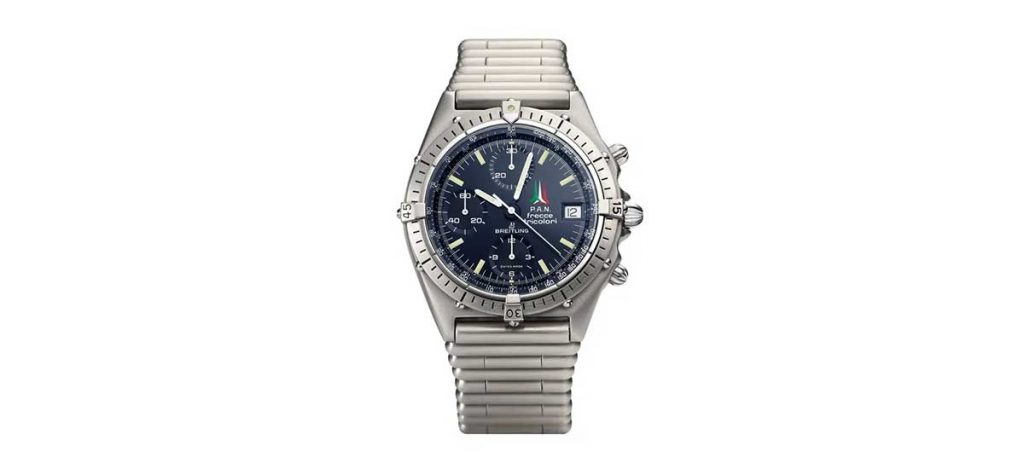
By the end of the decade, Breitling was providing chronographs for the Royal Air Force at the request of the British Air Ministry.
From this time on, Breitling would be renowned for its aviation watches. This led to the original Chronomat design. The Chronomat had a patented circular logarithmic slide rule applied to the chronograph.
The system was capable of easily handling a wide range of mathematical caliber operations with tachymeter, telemeter, and pulsometer functions; multiplication, division, and rule-of-three problems; production calculations, and more.
As an innovator, Breitling founded the “HUIT Aviation” department in 1938. This specialized department used the latest technology to test the quality and reliability of the collection.
This included a micro-oscillograph for radioelectric inspection of the movements, test simulators for temperatures ranging from -40℃ to +100℃, and “vibration tables” for stress testing the instruments in various positions.
The Duograph, introduced in 1944, employed a highly complicated split-second chronograph that would allow the user to time two separate events at once.
The other characteristic to note is that Breitling began to refine the style and appeal of their watches.
The perception of the collection, to this point, was of highly refined instruments, but Breitling wanted the brand to be more accessible and fashionable and therefore more desired by non-professionals. The Premier collection was unveiled featuring watches available in both stainless steel and gold.
1952, the Navitimer (a combination of the terms navigation and timer) was birthed out of the Chronomat watch. Breitling adapted the logarithmic slide rule feature for aviation purposes and integrated it into a rotating bezel, capped with small beads which made it easy to manipulate with a pilot’s gloved hand.
Two years later, the Aircraft Owners and Pilots Association announced that the Navitimer would be their official timepiece.
Breitling’s reputation as the premier aviator’s instrument was cemented and achieved a huge milestone.
Originally, the Navitimer was unavailable to the public, but Breitling saw the potential for the watch and added it to the collection for the masses.
In 1957, Breitling focused their sights on developing a watch for diving and aquatic enthusiasts.
The Superocean watch was born and featured water resistance to a depth of 200 meters or approximately 660 feet.
As space exploration became popular in the early 1960’s Lt. Commander Scott Carpenter, an astronaut and a fan of the Navitimer from his training days, approached Breitling about creating an astronaut’s version of the iconic pilot’s watch.
To satisfy the request, an enlarged rotating bezel was created for use with spacesuit gloves, and a 24-hour dial to differentiate day and night in the darkness of space was incorporated.
This led to the Cosmonaute timepiece…the first swiss made chronograph to have traveled to space.
The decade also saw the launch of the Top Time collection, a series of modern fashionable chronographs. This watch was worn by Sean Connery in the movie Thunderball.
1969 also saw the debut of the caliber Chrono-Matic self-winding chronograph movement. This groundbreaking achievement was developed in cooperation with Dubois Depraz, Heuer- Leonidas, and Hamilton Buren.
This early model had a crown on the left-hand side of the case with the pushers on the right side. 1985 saw the release of the Aerospace watch outfitted with a quartz movement and combining both analog and digital displays.
This unique timepiece was characterized by its ease of use and advanced technology. By 1999, Breitling determined that all of its movements would be certified by the COSC, and in 2001, opened the Breitling Chronmetrie in La Chaux-de-Fonds, Switzerland with the sole mission to produce all of its movements without outsourcing.
They were now part of an elite handful of watchmakers manufacturing their own movements.
Now that I have provided a historical overview of the innovations that both of these fine watch manufacturers have contributed, I will attempt to answer or offer commentary on some of the questions most often asked about each brand.
Are Panerai and Breitling good quality watches?
In looking at the evolution, creativity, and characteristics of each of these brands, I believe that the answer is a resounding yes.
The Breitling collection is not as expensive as the Panerai models but if you are interested in a watch so deeply aligned with aviation history or as a functional pilot’s instrument, the collection offers great depth and selection.
Panerai timepieces lean toward their diving history, but also offer a selection of fine complicated movements.
Are Panerai watches overpriced?
Here, I believe one needs to be very subjective. When weighing limited edition models and very complicated movements, value is truly in the eye of the beholder.
The collectible market and the daily watch-wearing individual are oft two completely different motivations in acquiring a watch.
If you are not factoring precious metals or gemstones into the price tag, it is the watch company’s choice of how they will price and market a particular model, and the buyers’ responsibility to weigh all the features and appearance of the watch to make the best decision.
Now that both companies produce their very own movements, they have both values added to each brand. I would not make the statement that Panerai watches are overpriced but are very unique timepieces.
Do Panerai or Breitling watches hold their value?
Once again, this relies on several factors. The most desired models are the watches that are the most sought after.
Servicing your timepiece regularly and not abusing your watch are important guidelines as you wear your watch.
Another factor is if you are buying a particular model as an investment, know that many watches do not have an unlimited value trajectory. There are periods where certain models are more valuable than others, as, in real estate, timing is often everything.
Who wears a Panerai watch?
Some of the individuals wearing Panerai watches are Mike Horn, the world’s greatest modern-day explorer, Gregorio Paltrinier, a world champion Olympic swimmer, and Sylvester Stallone who chose to wear a Panerai in the 1996 film Daylight. The timepieces are treasured for their accuracy and ruggedness among these types of elites.
Panerai Luminor Marina vs. Breitling Superocean
The Luminor Marina is available in different sizes and ranges from $8100-$13,900 with a top-of-the-line model offered at approx. $24,300 (available in a Goldtech case which is comprised of gold, 24% copper, and titanium).
The basic 44mm case models range from the strap version for $8100 or the all-steel version for approx. $8900.
Explore the
Biggest Pre-Owned Collection of Luxury Watches
These models have a Panerai caliber P9001 31 jewel automatic movement. A Glucydor balance and the incabloc anti-shock mechanism as well as two barrels and a total of 200 components and a power reserve of three days complete the movement.
There is also a carbotech model available which has a carbon ceramic case and bezel and brushed titanium back.
These models are water resistant to 300 meters. These 44mm models are available in either blue, olive green, or dark gray with complimenting straps.
There is also a limited edition Luminor Marina which has a 47mm case and retails for $10,100. This model has a Panerai P3001 caliber movement and is available with a dark brown dial and a brown strap.
Lastly, within the Marina collection, there are the ESteel models. They retail for $8700. And have polished steel bezels.
What differentiates these watches is that the cases are constructed of recycled materials comprising 58.4% of the weight of the case.
The Breitling Superocean has the benefits of being available in both men’s and women’s models.
The entrance price points range from $3700 to $6700 and are marketed as the ultimate sea watch. The base models offer a 42mm case with a 25 jewel movement and are water resistant to 500 m. (1650 ft).
The women’s models have a 36mm case with a 26 jewel movement and are available in eye-catching colors perfect for the beach or any aquatic activities.
The Superocean Automatic 42 has both a stainless steel and a 18kt. model with a Breitling caliber17 self-winding mechanical 26 jewel movement.
The case is 42mm and water resistant to 300m. A screw-locked 2 gasket crown and a cambered sapphire glare-proof front and rear crystal complete the presentation.
The Superocean Heritage is inspired by the original 1950s watch. These models range from $4500 to $19,600 at retail.
The base watch carries a Breitling caliber 10 self-winding 25 jewel movement with a 42-hour power reserve and is water resistant up to 100m. (330 ft,).
The special feature of these watches is that they are available with straps made up of ECONYL yarn.
These single-piece straps are made of repurposed nylon waste pulled out from the ocean ala fishing nets for instance.
The upper-end Heritage timepiece is the B20 Automatic 42. The case is comprised of 18kt. red gold.
Characteristics include a 26 jewel self-winding automatic movement with a 70-hour power reserve. It is water resistant to 200 m. and is completed with a rubber strap.
For comparability to perhaps a Panerai 183, I refer you to the following weblink that presents this model brilliantly.
Conclusion
In closing this article, I hope that I have provided ample information to help you in deciding whether a Panerai or a Breitling watch is the choice for you.
There are many prestigious brands such as the aforementioned and Rolex or Omega for instance.
Each has its stand-out features and something that differentiates each one from the other. In making your personal choice, I believe the greatest determiner of choice is “Do you want to wear a timepiece that everyone recognizes or one with a unique story and therefore a conversation piece?”
About Exquisite Timepieces
Established in 1998, Exquisite Timepieces is your one-stop shop for all things luxury watches! We are an authorized dealer for 60+ luxury watch brands including Omega, Hublot, Seiko, & Longines! We are proud to showcase one of the world’s largest pre-owned watch collections, including renowned brands like Rolex and Patek Philippe. Check out our brand new watch arrivals here and popular pre-owned listings here.


